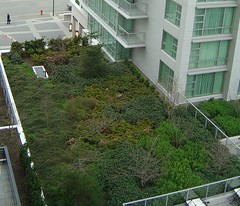 Image of Marriott Green Roof by pnrwa via Flickr
Image of Marriott Green Roof by pnrwa via Flickr
The Five Elements of Green Design by Rick L Walker
Successful sustainable construction begins with a design that addresses each of the following five central elements of green building design.
- Sustainable Site Design
- Water Conservation and Quality
- Energy and Environment
- Indoor Environmental Quality
- Conservation of Materials and Resources
- Reduce urban sprawl and destruction of land
- Promote higher density urban development
- Pursue brownfield development to save exiting green space
- Minimize site disturbance and restore natural habitat
- Only select a new site when necessary
- When a new site is necessary, do not chose a site that is critical to the local eco-system
- Orient the building to on the site to utilize natural resources like solar energy
- Select a site that allows access to mass transit
- Minimize the building's footprint by using existing surfaces, lightening roof color and using natural shading
- Realize that orientation of the proposed building that allows for natural drainage is often the least expensive way to improve the location
- Be certain that the site assessment captures the natural hydrological attributes
- Allow for the use of low-impact storm water retention
- Set a water budget and implement features that help achieve the budget
- Improve water conservation and quality by utilizing indigenous trees, plants and turf that do not require irrigation, fertilizers or pesticides
- Maximize passive solar orientation
- Reduce the need for artificial lighting by planning to use natural sunlight whenever possible
- Use exterior insulation to maximize the performance of the exterior envelope
- Use natural ventilation
- Use Energy Star energy efficient appliances
- Use new-age lighting products and settings
- Research all the new energy technologies
- Protect the building's interior during the construction process
- Make the building smoke-free
- Maximize the used of daylight sunlight
- Make sure that all interior finishes are environmentally friendly and safe
- Design a healthy heating, cooling and ventilating system
- Use engineer designed high stress materials whose strength reduces the quantity of used materials
- Use recycled materials whenever possible
- Use materials that can be recycled when their functional life has elapsed
- Support the local economy and reduce the transportation of materials by using local providers of local products
Rick Walker is the CEO of Green Efficient. GreenEfficient is the leader in the LEED building maintenance and operations market. Primarily serving Texas, their LEED Accredited Professionals (LEED-APS) manage commercial facilities using their integrated services portfolio of LEED-compliant janitorial services, Integrated Pest Management services, HVAC maintenance, lawn care services, purchasing oversight, occupant training and USGBC submittal services. Offices in Houston, Austin, Dallas and Corpus Christi enable the most active Texas LEED construction markets to be covered by their specialty services. For information on LEED, green building and sustainable products, visit their blog: theLEED
Article Source: http://EzineArticles.com/?expert=Rick_L._Walkerhttp://EzineArticles.com/?The-Five-Elements-of-Green-Design&id=2417950
http://thezeitgeistischanging.blogspot.com/
http://psychedelichippiefashion.blogspot.com/
http://psychedelichippiemusic.blogspot.com/
http://www.soul-flower.com/Merchant2/merchant.mvc?Screen=SFNT&Store_Code=SOS&AFFIL=Robert_Muller
No comments:
Post a Comment